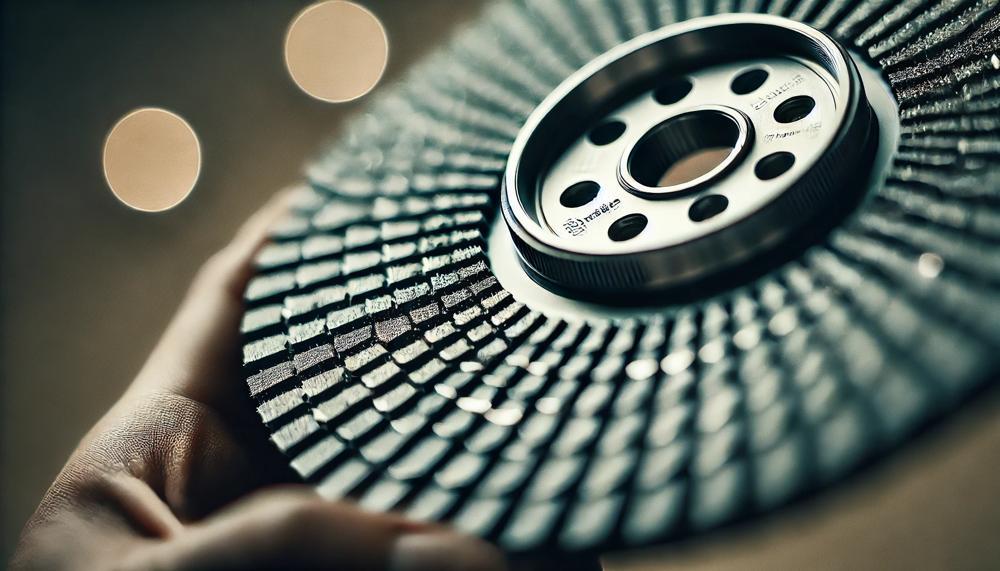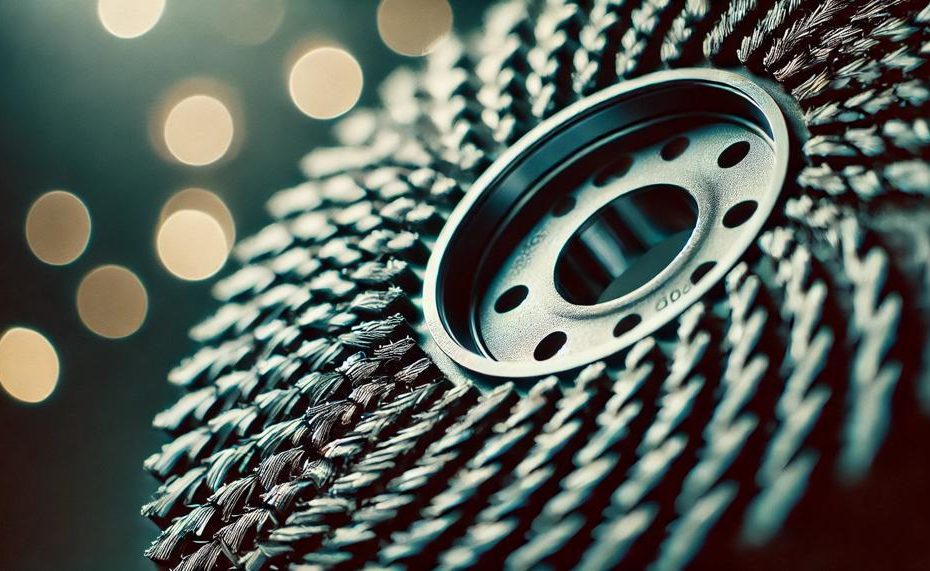Embarking on a mission to restore metal surfaces to their former glory involves more than just elbow grease and determination. The choice of tools, particularly when it comes to selecting the perfect flap disc for rust removal, can make the difference between a mediocre outcome and a remarkable transformation. Flap discs, those versatile pieces of abrasive engineering, are crucial in the battle against corrosion and wear. However, not all flap discs are created equal, and the key to unlocking their potential lies in understanding grit sizes.
This article is your compass in the vast sea of abrasive materials, guiding you to the right grit flap disc for every rust-removal task. Whether you’re a seasoned professional or a DIY enthusiast, the insights provided here will empower you to make informed decisions, ensuring your projects not only look good but also last longer.
Here’s a sneak peek at what you’ll learn:
- The Importance of Grit Size: How the size of the abrasive particles impacts the rust removal process.
- Choosing the Right Grit for Your Project: A guide to selecting the appropriate grit size based on the condition of the metal surface.
- Tips for Effective Rust Removal: Best practices for using flap discs to achieve a clean, smooth finish.
- Maximizing Flap Disc Longevity: How to extend the life of your flap discs and get the most value out of your investment.
Dive into the nuances of abrasive technology with us, and discover how choosing the right grit flap disc can elevate your rust removal projects from good to great.
Contents
- 1 What Grit Flap Disc for Removing Rust
- 2 Will You Need More Than 1 Grit Size To Get That Rust Off?
- 3 What Is The Best Grit Flap Disc For Surface Rust?
- 4 What Grit Flap Disc To Use For Pitted Rust
- 5 When Your Panel Or Railing Is Rusted Right Through
- 6 Is Aluminum Oxide Or A Zirconia Flap Disc Better For Taking Rust Off?
- 7 Removing Rust With A Type 27 Or Type 29 Flap Disc
- 8 And Before You Take Your Flap Disc To Your Rust
- 9 Remove Rust On Stainless Steel – What Grit?
- 10 Conclusion
What Grit Flap Disc for Removing Rust
Selecting the right grit flap disc for rust removal is a bit like picking the correct fishing gear. You need the right equipment to reel in a smooth, rust-free surface. Let’s tackle this task head-on with some wisdom and wit, ensuring you’ve got the perfect tools in your arsenal for battling rust.
Coarse Grit for Heavy Rust:
For a surface that’s seen better days, choked in rust, we’re talking a coarse approach. Imagine you’re setting off to smooth a rugged mountain into a plain. You’d start with the heavy gear, wouldn’t you?
- 40 Grit: This is your bulldozer. It tears through the rust like it’s butter, making quick work of the heavy stuff. Ideal for when you’re dealing with a layer of rust that looks like it’s been there since the Iron Age.
- 60 Grit: Think of this as your sturdy pickaxe. It’s not as aggressive as the 40, but it’ll still clear away significant rust without taking too much of the metal with it.
Medium Grit for Refining:
Once you’ve cleared the major debris, it’s time to refine. You wouldn’t sand a sculpture with a chainsaw, right?
- 80 Grit: Your fine chisel. It smooths out the scratches left by the coarser grits, prepping the surface for a finer finish without stripping too much away.
- 120 Grit: Consider this your sandpaper. It’s perfect for those finishing touches, ensuring the surface is smooth and ready for painting or sealing.
Fine Grit for Finishing Touches:
For the final flourish, a touch as light as a painter’s brush is needed.
- 180-240 Grit: This is your polish, the last sweep of the brush that brings out the shine. Ideal for when you’re aiming for a surface so smooth, it’d make a marble statue jealous.
Let’s lay it out in a table for easy reference:
| Grit Level | Use Case | Description |
| 40 Grit | Heavy Rust Removal | Your bulldozer for tearing through heavy rust. |
| 60 Grit | Moderate Rust Removal | Your sturdy pickaxe for less aggressive rust removal. |
| 80 Grit | Refining Surfaces | Your fine chisel for smoothing out coarse scratches. |
| 120 Grit | Further Refining | Your sandpaper for those finishing touches. |
| 180-240 Grit | Polishing | Your polish for a mirror-like finish. |
Each metal and project might whisper its needs, so listen closely. Starting with a coarser grit and working your way up based on the metal’s feedback is like conversing with the material. It’s about finesse, not force.
Will You Need More Than 1 Grit Size To Get That Rust Off?
The straight dope is yes, indeed you will. The journey from a rusted to a restored surface isn’t a one-step dance.
It’s more akin to a carefully choreographed ballet, involving moves from coarse grits that tackle the rough and tumble of rust removal to finer grits that smooth things over, leaving a surface that’s almost as good as new. Here’s the skinny on what you’re looking at when it comes to grit sizes:
| Grit Size | Use Case | Outcome |
| 40 or 60 (Coarse) | Knocking out the heavy rust | Removes layers of corrosion quickly but leaves a rougher surface |
| 80 to 120 (Medium) | Smoothing the surface | Begins to smooth out scratches from the coarser grit, prepping for finishing |
| 180 to 240 (Fine) | Finishing touches | Achieves a smooth, rust-free surface ready for painting or further treatment |
Starting with a coarser grit, such as a 40 or 60, is akin to breaking ground with a hefty spade, shifting the bulk of the rust with brute force. This coarser grit is your frontline warrior, cutting through the corrosion with gusto. Yet, it’s a tad too rough around the edges to finish the job alone.
Transitioning to a medium grit, say an 80 to 120, is your next savvy move. This is where things start getting a bit more refined, smoothing out the battle scars left by your coarse compatriot. It’s a necessary step to bridge the rough start with a smooth finish.
Finally, a fine grit, between 180 to 240, is akin to the polish on a gentleman’s shoe – it’s what brings out the shine. This stage is where your surface starts to truly sing, free of rust and smooth as silk.
What Is The Best Grit Flap Disc For Surface Rust?
Choosing the best grit flap disc for removing surface rust depends on a few key factors: the severity of the rust, the type of metal being worked on, and the desired finish. Here’s a guide to help you select the right grit for your project:
| Severity of Rust | Recommended Grit | Reasoning |
| Heavy Rust | 40-60 | Coarse grits like 40 or 60 are adept at quickly tearing through heavy rust, efficiently clearing the surface. However, they might leave behind some scratches, necessitating a follow-up with finer grits for a polished finish. |
| Light to Moderate Rust | 80-120 | These medium grits are excellent for removing lighter rust layers without causing significant abrasion to the metal beneath. They strike a balance between efficient rust removal and maintaining the integrity of the surface. |
| Finishing Touches | 180-240 | After the bulk of rust has been removed, fine grits like 180 or 240 are used to polish the surface, giving it a smooth and shiny finish. This step is crucial for projects where appearance matters. |
Bear in mind, the type of metal plays a pivotal role in choosing your flap disc. Softer metals such as aluminium necessitate a gentler approach with finer grits, whereas harder metals like steel can withstand the vigor of coarser grits.
Also, consider the overall goal of your project. If you’re prepping for painting or coating, a smoother finish with finer grits will ensure better adhesion. On the flip side, if you’re merely removing rust for functional reasons and not aesthetic ones, starting and ending with a coarser grit might suffice.
Remember, always start with a test area to gauge the impact of your chosen grit on the specific metal you’re working with. This ensures you don’t inadvertently damage your piece with a grit that’s too coarse for your needs.
What Grit Flap Disc To Use For Pitted Rust
When tackling the stubborn menace of pitted rust on metal surfaces, choosing the right tool for the job makes all the difference. For those ready to battle this blight, the grit of the flap disc you select is pivotal. Aim for a disc that’s tough on rust yet kind to the underlying metal.
In this case, the 40 or 60 grit flap disc emerges as your champion. These grades strike the perfect balance, grinding away the corrosion without undue harm to the surface beneath.
Consider this straightforward guide on flap disc selection for rust removal:
| Grit Size | Use Case | Best For |
| 40 Grit | Heavy-duty rust removal | Quickly tackling thick, pitted rust without damaging the metal integrity |
| 60 Grit | General rust removal | Removing moderate pitting and surface imperfections, preparing metal for finishing |
A 40 grit flap disc is your go-to for aggressively attacking deep, pitted rust. It’s a bit of a rough chap but does the job with gusto, clearing the way for finer work. On the other flank, the 60 grit is a tad more refined, suited for rust that’s not as deeply entrenched or for smoothing out the scars left by its coarser cousin.
Remember, it’s not just about muscling away the rust; it’s about restoring metal to its former glory with precision and care.
When Your Panel Or Railing Is Rusted Right Through
When tackling the beast of rust that’s gnawed through your panels or railings, reaching for the right grit flap disc isn’t just smart; it’s essential. Here’s why the correct choice matters immensely:
| Grit Size | Function | Outcome |
| Coarse (40-60) | Removes severe rust, heavy coatings, and surface irregularities | Quickly strips rust, leaving a surface prepped for finer smoothing |
| Medium (80-120) | Smoothens out scratches from coarser grits, eliminates finer rust particles | Creates a cleaner, more uniform surface ready for finishing touches |
| Finishing (Higher than 120) | Polishes the metal, prepping it for painting or sealing | Leaves a sleek, smooth finish, minimizing the risk of future rust |
Initiating your salvage operation with a coarse (40 or 60 grit) flap disc lets you aggressively confront the rust head-on, stripping away the decay with gusto. This grit tears through the crust of time, peeling back the layers of neglect. Yet, it’s but the first step in a dance of restoration.
Following this, a medium grit (80 to 120) steps in like a skilled artisan, refining what the brute force began. It smoothens the scars left by its coarser predecessor, blending the harsh lines into a canvas of potential.

For the finishing touch, a higher grit flap disc, north of 120, acts with the precision of a jeweler, polishing the metal to a shine that beckons the eye. It prepares your panel or railing not just for a coat of paint but for years of resilience against the relentless siege of the elements.
Each grit plays its part in a symphony of restoration, transforming a forlorn piece of metal into a bulwark ready to stand anew. It’s not just about removing rust; it’s about reviving strength, and with the right grit flap disc, you wield the power to turn back time on the damage wrought by neglect.
Is Aluminum Oxide Or A Zirconia Flap Disc Better For Taking Rust Off?
When deciding whether to use aluminum oxide or zirconia flap discs for rust removal, it’s important to weigh their unique characteristics against the specifics of your project. Here’s a straightforward comparison:
| Aspect | Aluminum Oxide | Zirconia |
| Material Origin | Synthetic | Natural mineral |
| Cost | More affordable | Higher price |
| Lifespan | Shorter lifespan | Longer lifespan |
| Grit Size | Wider range, suitable for light rust | Smaller grit sizes, ideal for heavy-duty rust |
| Heat Resistance | Lower heat resistance | Higher heat resistance |
| Application | Aggressive cutting, thick rust removal | Controlled cut, smooth finishing |
Removing Rust With A Type 27 Or Type 29 Flap Disc
In the gritty world of metalwork, understanding the nuances of tools like flap discs is paramount, particularly when it comes to battling the relentless foe that is rust. Let’s slice through the details.
Type 27 vs Type 29 Flap Discs: The Key Differences
| Feature | Type 27 Flap Disc | Type 29 Flap Disc |
| Shape | Flat Face | Angled Face |
| Best For | Blending, Smoothing Finishes | Shaping, Contouring Uneven Surfaces |
| Rust Removal Efficiency | High on Flat Surfaces | High on Uneven Surfaces |
Which Flap Disc for Rust Removal?
The decision between the Type 27 and Type 29 comes down to the battlefield you’re facing. If you’re up against rust on flat metal landscapes, the Type 27 is your trusty ally, smoothing your way with its flat face. However, if the rust is lurking on uneven surfaces, challenging the norms of smoothness, the Type 29 is your go-to weapon, its angled face adept at navigating contours and crevices.
Both types of flap discs have their own strategic strengths in the relentless quest to vanquish rust. Remember, the true effectiveness of these tools lies not just in their individual attributes but in how well they align with the contours of your project.
And Before You Take Your Flap Disc To Your Rust
Before you wield your flap disc against the tenacious foe of rust, it’s pivotal to arm yourself with knowledge to ensure the metal emerges victorious, unscathed in its renewed glory. Let’s delve straight into the key considerations:
Rust Severity and Metal Type
The battle against rust begins with gauging its stronghold. Heavier rust demands a coarser grit, but heed the metal’s call.
You wouldn’t unleash the same fury on soft copper as on hardy steel. It’s not just about removing rust; it’s about honouring the metal’s essence.
Grit Size: The Artisan’s Choice
Selecting grit size is akin to an artist choosing a brush. Coarse grits (40-60) strip back the layers of neglect, while finer grits (80-120) finesse the surface, erasing the coarse aftermath, culminating in a polish with a fine grit (180-240) that reflects the artisan’s care.
Considerations Beyond the Surface
Beyond rust, there might lurk paint or protective coatings. A gentle touch with a lower grit ensures you remove only what’s necessary, preserving the integrity beneath.
The Symphony of Metal and Disc
The flap disc material orchestrates the grinding harmony. Aluminum oxide, zirconia alumina, and ceramic grain each play a distinct tune, tailored for the metal’s tempo, from general grinding to high-pressure performance.
A Dance of Flexibility
A good flap disc doesn’t just grind; it dances to the metal’s contours, ensuring a finish that’s both smooth to the touch and easy on the ears, minimizing noise and vibration.
Arming yourself with this knowledge ensures that when you reach for your flap disc, you’re not just removing rust; you’re crafting a masterpiece.
Remove Rust On Stainless Steel – What Grit?
When tackling the task of removing rust from stainless steel, the choice of grit size on your flap disc is paramount to achieving a spotless, rejuvenated surface. The key lies in striking the perfect balance between rapid rust removal and maintaining the pristine condition of the stainless steel beneath. Let’s dive into the specifics to guide you on selecting the ideal grit for your project.
The Right Grit for Stainless Steel Rust Removal
| Grit Size | Usage | Result |
| 40-60 | Heavy rust removal | Quickly strips rust, leaves surface scratches |
| 80-120 | Moderate rust removal and smoothing | Balances removal and finishing, minimises scratches |
| 180-240 | Finishing touches | Produces a smooth, polished surface |
Understanding the Choice
- Heavy Rust Removal: For stainless steel plagued by severe rust, starting with a coarser grit (40-60) flap disc can strip away the corrosion swiftly. It’s a brisk approach, yet it may etch the metal’s surface with scratches. This step is ideal for preparing the steel for finer finishing.
- Moderate Rust Removal and Smoothing: Once the bulk of rust is cleared, shifting to a medium grit (80-120) flap disc smooths out the scratches left by the coarser grit, efficiently refining the steel’s surface. It’s a judicious balance, offering both removal and surface prep for the final polish.
- Finishing Touches: For the final flourish, a fine grit (180-240) flap disc is your ally. It buffs away any lingering imperfections, leaving behind a smooth, gleaming surface that mirrors the inherent resilience and beauty of stainless steel.
Choosing the correct grit size is akin to selecting the right tool for the right job—essential for optimal results. Remember, it’s not just about removing the rust; it’s about restoring the stainless steel to its former glory, ensuring it remains a testament to both its strength and elegance.
Conclusion
In the art of restoring metal to its original luster, selecting the right flap disc grit for rust removal is akin to choosing the perfect brush for a masterpiece painting.
The detailed exploration above highlights not just the importance of grit size in conquering corrosion but also underscores the nuanced approach needed to rejuvenate various metals, especially stainless steel. From the aggressive removal of obstinate rust with coarse 40-60 grit discs to the delicate polishing finesse of 180-240 grits, each step in this carefully choreographed ballet of abrasion serves a specific purpose.
This journey from the rugged terrain of heavy corrosion to the smooth plains of a polished finish emphasizes the transformative power of the right tools in skilled hands. Moreover, the guide delves into the strategic use of different materials like aluminum oxide and zirconia, alongside the considerations for flap disc types (Type 27 vs Type 29), offering a comprehensive toolkit for anyone facing the challenge of rust.
Whether tackling a deeply pitted menace or refining a surface to mirror-like perfection, the wisdom shared here illuminates the path to not just effective rust removal but a celebration of metal’s enduring beauty.





